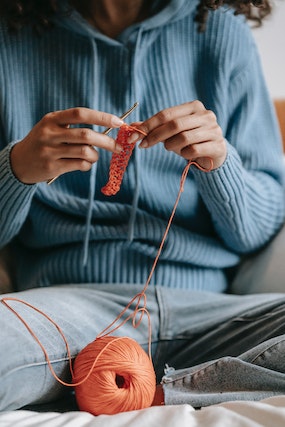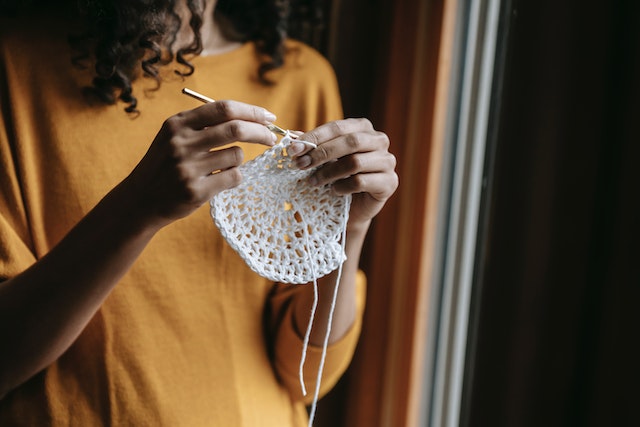A hook, some yarn, and the great pastime of crocheting enable you to produce stunning works of art. But let’s face it, getting started might be a little intimidating. There are numerous typical errors beginners make when learning to crochet, from selecting the proper yarn to properly following patterns. Be at ease! We will go over these errors in detail and offer advice on how to learn to crochet in this blog article so that you may master crochet in no time!
Choosing the incorrect yarn type
One of the most typical errors beginners make when learning to crochet is choosing the incorrect type of yarn. Though it’s simple to be seduced by appealing hues and textures, not all yarns are created equal.
Making the error of using a thick or textured yarn for their first project is common among novices. These yarns can add interest to your creations, but they can be challenging for novices to work with because it can be challenging to determine where your stitches should go.
Another common error is choosing a synthetic blend or 100% acrylic without taking its qualities into account. Over time, these yarns can readily pill and have a poor tendency to keep their shape.
Before buying any kind of yarn, it’s crucial to thoroughly read the label; pay attention to the weight, fibre content, suggested hook size, and care recommendations. This will make sure you’re utilising the appropriate material for the project you want to do.

Selecting the incorrect crochet hook
Inexperienced crocheters frequently make the error of selecting the incorrect hook for their project. Making the wrong choice in hook size or type can be frustrating and possibly have an impact on the completed result.
First of all, it’s crucial to realise that various hooks are made for various kinds of yarn. For a fine weight yarn, a smaller hook would be appropriate, whilst a larger one would be ideal for thick or bulky yarns. The incorrect size can lead to uneven stitches that don’t follow your pattern.
The material of your crochet hook is another thing to take into account. Metal hooks are excellent for novices because their smooth surface makes it easy for stitches to glide over them. However, given that they are more pleasant to handle, some people might prefer utilising wooden or plastic hooks.
In addition, there are particular kinds of crochet hooks made for particular types of crafts, such Tunisian or double-ended crochet. Prior to beginning any project, it’s critical to do your study on the type of hook you require.
Although picking the proper crochet hook might seem like a little consideration, it can have a significant impact on your outcomes and crocheting experience as a whole. It will ultimately save you from frustration and disappointment if you take your time to make a sensible decision!
Not correctly adhering to patterns
The failure to accurately follow patterns is one of the most frequent errors beginners make when beginning to crochet. This might result in a finished product that does not match the planned design, as well as dissatisfaction and misunderstanding.
Many newbies make the error of skipping crucial steps or assuming they already know how to do something without carefully reading all of the instructions. Before commencing anything, it is imperative to thoroughly study the pattern from beginning to conclusion.
Using wrong stitch counts or switching up stitches in locations where it is important to preserve uniformity are other typical mistakes. It’s crucial to never presume and to always carefully follow directions because even the smallest adjustments can completely screw up a project.
Additionally, disregarding gauge measurements may cause a finished object to have dimensions that are entirely different from what was intended. Many crocheters disregard gauge because they think their tension doesn’t matter; yet, since everyone has a different level of tension, this step is crucial.
Your development as a beginner crocheter will be hampered if you ignore important elements in patterns. You may easily produce attractive products by paying close attention and using extra caution while carefully following the directions!

Not enough training
Lack of practice is a common error that beginners who are starting to crochet make. A new activity might be exciting, but without regular practice, progress may be slow or nonexistent.
The abilities needed to produce complicated designs in crochet involve muscle memory and practise. Your hands find it challenging to recall the proper form for each stitch without regular practice.
Over time, even only 10 to 15 minutes a day of practice can have a significant impact on your ability level. Instead of trying to squeeze in hours of practice once a week, it is preferable to do a little bit every day.
Regular practice also makes it easier for you to spot any errors or trouble spots. It could take longer for you to realise whether you’re holding the yarn wrong or making other mistakes if you just pick up your hook occasionally.
So try to incorporate practising crochet into your daily routine, whether it means doing it during TV commercial breaks or scheduling aside time specifically for it. Your abilities (and completed projects) will be appreciated!